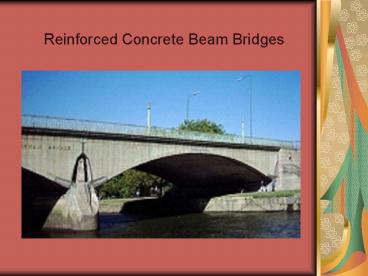Reinforced Concrete Beam Bridges - PowerPoint PPT Presentation
1 / 15
Title: Reinforced Concrete Beam Bridges
1
Reinforced Concrete Beam Bridges
2
Concrete
- Oldest building material
- Widely used
- Cement, rock, sand, and water mixture
- Concrete hardens for weeks (forever)
- Strength is tested 28 days after setting
- Strength up to 5000 pounds/in2
- Tensile strength 1/10th of compression
- Fly ash and silica fume increase strength of
concrete
3
What is reinforced concrete?
- Embedded iron/steel bars in concrete
- High compression capacity for concrete
- Low tensile strength
- Steel rod supplies tensile strength
- Able to support large weights
4
Load Capacities
Dead loads - Weight of bridge and all its
components This load is known. Increasing
factor in larger span bridges. Live loads -
people crossing river, cattle, horses, and
carts Due to the variation of live loads on the
bridge, large safety margins must be considered.
5
Stresses on Beam
Beam
Compression
Load
Tension
Concrete absorbs compression forces Steel placed
at the bottom absorbs tension forces
6
Span and Columns of Beam Bridges
Beam
Longer spans require piers or columns to support
the dead weight of the bridge itself.
Beam
7
Piers/Columns of Beam Bridges
- More piers allow for shorter beams.
- Too many piers can obstruct water flow.
- Underground depth of 3-5 ft for each pier.
- 7-14 days for foundation to set.
8
Types of Reinforced Beams
T - Beam
I - Beam
Material distributed at the top. Used in
construction floors.
Material distributed at the top and bottom.
9
Inverted T Beam
SBB beam
I Beam
M Beam
Box Beam
U Beam
10
Types of Reinforced Concrete Bridges
Solid Slab - short span ( less than 20
meters) T-beams mostly used Beam and Slab -
medium span (20 to 35 meters) M, I and U beams
used Common type of medium span bridge Beams
placed side by side
11
(No Transcript)
12
Pros and Cons
- Cons
- Corrosion of steel beams
- Beams are generally massive to sustain all
tensile forces - Cracks in concrete
- Pros
- Easily supported
- Minimal thermal effects
- Thinner bridges
- Not affected by movements in the ground
13
Repairing concrete bridges
- Cracks
- Overload, rusting, and weathering cracks
- Normal width 0.2 to 0.5 mm
- Cracks greater than this lead to heavy corrosion
of iron bars - Portland cement and mortar
14
Reinforced Concrete Pedestrian Bridge
- Highly durable bridge.
- Maybe too much for our purposes.
- Beams cannot be constructed on site.
- Transporting beams to site would be costly.
15
References
Cope, R.J. Concrete Bridge Engineering
Performance and Advances. New York Elsevier
Applied Science, 1987. Johnson, Stephen, and
Roberto Leon. Encyclopedia of Bridges and
Tunnels. New York Facts On File, Inc, 2002.
Wittfoht, Hans. Building Bridges. Dusseldorf
Beton-Verlag, 1984. Raina, V.K. Concrete
Bridges. New York McGraw-Hill, 1996. Dr.
Durrani































